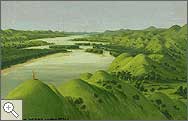
In the artist's words: "I took my easel and canvas and brushes to the top of the bluff, and painted two views from the same spot. These hills [were] five or six hundred feet high and every foot of them, as far as they can be discovered in distance, covered with a vivid green turf. From this enchanting spot there was nothing to arrest the eye from ranging over [the Missouri's] waters for the distance of twenty or thirty miles."
Quoted in William H. Truettner, The Natural Man Observed: A Study of Catlin's Indian Gallery (Washington, D.C.: Smithsonian Institution Press, 1979), p. 247.
George Catlin was an easterner who had been fascinated with Native Americans since boyhood. When he was thirty-four years old, he decided that painting pictures of Native Americans would be far more interesting than being a lawyer. So, in 1830 he headed west. For six years, he moved from village to village, using the Missouri River as a means of travel. He painted portraits of tribal chiefs and scenes of buffalo hunts, dances, and other Native American ceremonies.
|
 |
 |
 |
 |

George Catlin, River Bluffs, 1,320 Miles above St. Louis
|
 |
 |

Smithsonian American Art Museum, Smithsonian Institution. Gift of Mrs. Joseph Harrison,Jr.
|
 |
 |
 |
|

